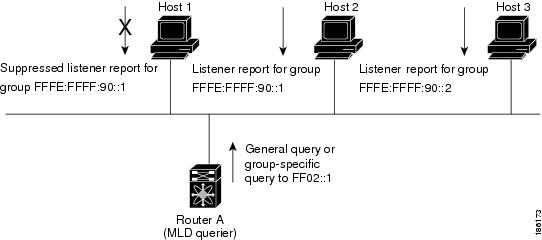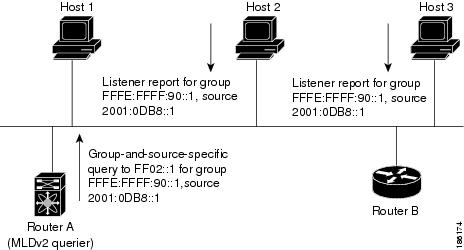About MLD
MLD is an IPv6 protocol that a host uses to request multicast data for a particular group. Using the information obtained through MLD, the software maintains a list of multicast group or channel memberships on a per-interface basis. The devices that receive MLD packets send the multicast data that they receive for requested groups or channels out the network segment of the known receivers.
MLDv1 is derived from IGMPv2, and MLDv2 is derived from IGMPv3. IGMP uses IP Protocol 2 message types while MLD uses IP Protocol 58 message types, which is a subset of the ICMPv6 messages.
The MLD process is started automatically on the device. You cannot enable MLD manually on an interface. MLD is enabled automatically when you perform one of the following configuration tasks on an interface:
-
Enable PIM6
-
Statically bind a local multicast group
-
Enable link-local group reports
MLD Versions
The device supports MLDv1 and MLDv2. MLDv2 supports MLDv1 listener reports.
By default, the software enables MLDv2 when it starts the MLD process. You can enable MLDv1 on interfaces where you want only its capabilities.
MLDv2 includes the following key changes from MLDv1:
-
Support for Source-Specific Multicast (SSM), which builds shortest path trees from each receiver to the source, through the following features:
-
Host messages that can specify both the group and the source.
-
The multicast state that is maintained for groups and sources, not just for groups as in MLDv1.
-
-
Hosts no longer perform report suppression, which means that hosts always send MLD listener reports when an MLD query message is received.
For detailed information about MLDv1, see RFC 2710. For detailed information about MLDv2, see RFC 3810.
MLD Basics
The basic MLD process of a router that discovers multicast hosts is shown in the figure below.

Hosts 1, 2, and 3 send unsolicited MLD listener report messages to initiate receiving multicast data for a group or channel. Router A, which is the MLD designated querier on the subnet, sends a general query message to the link-scope all-nodes multicast address FF02::1 periodically to discover which multicast groups hosts want to receive. The group-specific query is used to discover whether a specific group is requested by any hosts. You can configure the group membership timeout value that the router uses to determine if any members of a group or source exist on the subnet.
Host 1’s listener report is suppressed, and host 2 sends its listener report for group FFFE:FFFF:90::1 first. Host 1 receives the report from host 2. Because only one listener report per group needs to be sent to the router, other hosts suppress their reports to reduce network traffic. Each host waits for a random time interval to avoid sending reports at the same time. You can configure the query maximum response time parameter to control the interval at which hosts randomize their responses.
 Note |
MLDv1 membership report suppression occurs only on hosts that are connected to the same port. |
Router A sends the MLDv2 group-and-source-specific query to the LAN. Hosts 2 and 3 respond to the query with listener reports to indicate that they want to receive data from the advertised group and source. This MLDv2 feature supports SSM.
 Note |
In MLDv2, all hosts respond to queries. |

The software elects a router as the MLD querier on a subnet if it has the lowest IP address. As long as a router continues to receive query messages from a router with a lower IP address, it remains a nonquerier and resets a timer that is based on its querier timeout value. If the querier timer of a router expires, it becomes the designated querier. If that router later receives a host query message from a router with a lower IP address, it drops its role as the designated querier and sets its querier timer again.
Messages sent by the designated querier have a time-to-live (TTL) value of 1, which means that the messages are not forwarded by the directly connected routers on the subnet, and you can configure the frequency and number of query messages sent specifically for MLD startup. You can configure a short query interval at startup so that the group state is established as quickly as possible. Although usually unnecessary, you can tune the query interval used after startup to a value that balances responsiveness to host group membership and the traffic created on the network.
 Caution |
If you change the query interval, you can severely impact multicast forwarding in your network. |
When a multicast host leaves a group, it should send a done message for MLDv1 or a listener report that excludes the group to the link-scope all-routers multicast address FF02::2. To check if this host is the last host to leave the group, the software sends an MLD query message and starts a timer that you can configure called the last member query response interval. If no reports are received before the timer expires, the software removes the group state. The router continues to send multicast traffic for a group until its state is removed.
You can configure a robustness value to compensate for the packet loss on a congested network. The robustness value is used by the MLD software to determine the number of times to send messages.
Link local addresses in the range FF02::0/16 have link scope, as defined by the Internet Assigned Numbers Authority (IANA). Network protocols on a local network segment use these addresses; routers do not forward these addresses because they have a TTL of 1. By default, the MLD process sends listener reports only for nonlink local addresses, but you can configure the software to send reports for link local addresses.
MLD Snooping
Multicast Listener Discovery (MLD) snooping enables the efficient distribution of IPv6 multicast traffic between hosts and routers. It is a Layer 2 feature that restricts IPv6 multicast traffic within a bridge-domain to a subset of ports that have transmitted or received MLD queries or reports. In this way, MLD snooping provides the benefit of conserving the bandwidth on those segments of the network where no node has expressed interest in receiving the multicast traffic. This reduces the bandwidth usage instead of flooding the bridge-domain, and also helps hosts and routers save unwanted packet processing.
The MLD snooping functionality is similar to Internet Group Management Protocol (IGMP) snooping, except that the MLD snooping feature snoops for IPv6 multicast traffic and operates on MLDv1 (RFC 2710) and MLDv2 (RFC 3810) control plane packets. MLD is a sub-protocol of Internet Control Message Protocol version 6 (ICMPv6), so MLD message types are a subset of ICMPv6 messages and MLD messages are identified in IPv6 packets by a preceding next header value of 58. Message types in MLDv1 include listener queries, multicast address-specific (MAS) queries, listener reports, and done messages. MLDv2 is designed to be interoperable with MLDv1 except that it has an extra query type, the multicast address and source-specific (MASS) query. The protocol level timers available in MLD are similar to those available in IGMP.
When MLD snooping is disabled, then all the multicast traffic is flooded to all the ports, whether they have an interest or not. When MLD snooping is enabled, the fabric will forward IPv6 multicast traffic based on MLD interest. Unknown IPv6 multicast traffic will be flooded based on the bridge-domain's IPv6 L3 unknown multicast flood setting.
Flooding mode is used for forwarding unknown IPv6 multicast packets. In the flooding mode all endpoint groups (EPGs) and all ports under the bridge-domain will get the flooded packets.
 Feedback
Feedback